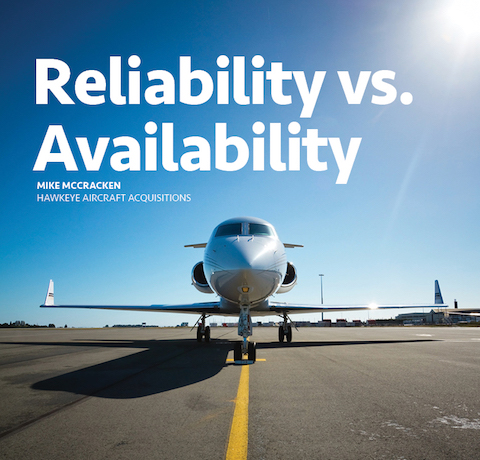Reliability versus Availability
As published in Business Air issue #9 2017
This article is for anyone owning a plane, whether you just purchased it new, used or have an existing aircraft. Understanding what these terms really mean to your operation is important. It can shed light on a problem aircraft, it can show that your current aircraft is getting too old to keep up with your missions and it can show trends. Most importantly, it can be a tool for analyzing aircraft using empirical data.
First what do these terms really mean? Most people understand reliability. You go to the plane and it either starts and you can make your mission or it doesn’t and therefore your dispatch reliability is affected. It does not take many no go’s before everyone is wondering about the aircraft. The NBAA has a formula for determining dispatch reliability.
The second term, which is a little bit more complicated, is availability. What does it mean and how do you calculate? The concept of availability is all about if I want to go today, is my aircraft able to do the mission. It isn’t whether it will start and do the mission, it is if anytime in a 24/7 period if I called, could the plane fly.
The concept of a business aircraft is on demand 365 days a year 24/7. That is one reason companies utilize an aircraft for the pop up opportunity, or to handle an emergency. Routine scheduled trips are the bread and butter of an operation, but when downtown calls, having the aircraft ready to go, even for a pop up routine trip, is important. After all, part of the premium of having your own aircraft is that ability to go on your schedule.
This is an important concept because as aircraft age, they become more prone to needing additional maintenance. There is a cost to this down time and reliability does not capture this, as most flight departments will move heaven and earth to make sure the plane can fly. I have seen planes come in and mechanics virtually work 3 days around the clock to get the plane ready for the next trip. The CEO comes out and makes the trip and everything is fine. The director of aviation, after a few months of these heroics, tells the CEO that the plane just isn’t reliable and we need to consider upgrading. The CEO looks confused, as every time he needed the plane, it made the trip. The dispatch reliability has been 100% but their availability might have been 80%.
Older aircraft also typically need more time in big inspections. By using availability of the aircraft and calculating the cost of downtime, you might be better authorizing overtime to get the plane out a few days early. Or another example might be, you just bought a new aircraft and while it is making every trip, it is spending a great deal of time in the shop or down for maintenance. By tracking availability you now have hard data to present to the OEM and help make the case for extending warranties or additional support.
There is a cost of overhead for the plane not to fly. The more times the plane comes in with issues, the lower the availability becomes, and this can alert you in hard data terms that the plane is becoming less reliable. (Note, the word reliable in this sense is not saying it doesn’t make every trip.) It could still have a dispatch reliability of 100% but an availability of 80% or less. A good baseline for availability is 96%.
If you started keeping data from the beginning of your ownership, you could then monitor the trends giving you much more hard data on the health of the plane. However, it is never too late to start collecting this data. The more data points you have the more trends become apparent. We have also used this data to compare new versus buying used, downtime between models and timing considerations for when to trade aircraft.
For more information please contact me. We will be happy to share our spreadsheet free of charge.
Mike McCracken
President
Hawkeye-aircraft Acquisitions





